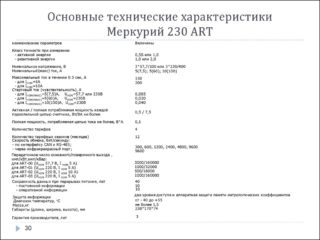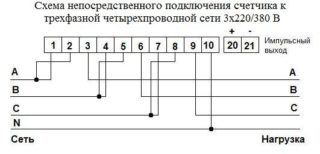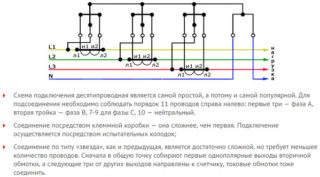To account for electricity in three-phase circuits, meters of a special design are used, registering its consumption for each of the phases. Features of operating modes in power lines force the use of special converters for taking readings - current transformers (CT). Direct connection of a three-phase Mercury meter, for example, to such a circuit is allowed only under one condition. The presence of restrictions is explained by the fact that the currents flowing in the monitored line should not exceed the limit value of 60 Amperes.
Advantages of installing and operating the product Mercury 230
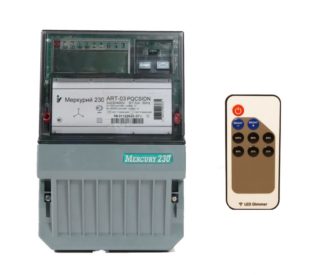
Electricity meters of the class in question are metering devices with the help of which it is possible to measure the energy consumed in three-phase circuits. The advantages of this type of electronic device include:
- the ability to meter electricity at various rates;
- admissibility of operation in three-phase networks, the connection to which is carried out directly or through current transformers;
- the ability to work individually or as part of dispatch equipment;
- extended functionality provided by the features of inclusion in the general power system.
The devices are successfully used not only in industrial enterprises and other production facilities, but also in private houses, where three supply phases are used quite often.
The need for a 380 volt power supply is explained by the use of power equipment, which includes electric motors. They work successfully only in the presence of three phase voltages and are used in borehole pumps, machine tools and other pieces of equipment used for personal purposes.
Electricity meter characteristics
- Display of data on consumed electricity for any of the provided operating modes: night, day, preferential, etc.
- Energy consumption metering according to one of 4 tariff modes with 16 overlapping zones in time.
- Counting and registration of current and frequency parameters.
- Consumption control through the interface (from the central control room).
- Saving in the device memory up to 10 most important events, as well as moments of disappearance of individual phases, their exceeding the permissible values, opening dates and changes in the tariff regime.
The meter also provides a special type of protection that excludes the possibility of unauthorized entry when attempting to steal electricity. In these devices, the readings are taken according to the "cumulative total" algorithm, which does not depend on the instantaneous direction of the current.
Why do we need TT
Connecting three-phase meters through Mercury current transformers makes it possible to expand the range of measured parameters to several hundred Amperes. This can be achieved through the use of converting devices with a fixed transformation ratio (most often it is equal to 20). Since the counters of the Mercury type are designed for currents of no more than 60 Amperes, the use of a transformer makes it possible to take readings at their values in the supply circuits, reaching many hundreds of Amperes.
For other TT models, the transformation ratio has "its own" values (5, 30, 40, etc.).
The choice of a specific sample of the converter depends on the calculated level of current load in the consumer network. If the current value does not exceed 60 Amperes, which happens extremely rarely, a direct connection of the meter to the monitored circuit is allowed.
Connection diagrams
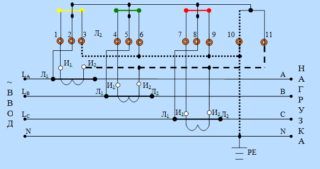
The scheme for connecting the meter through current transformers Mercury 230 provides several ways to turn it on, which differ in the switching of linear conductors: semi-indirect connection; direct inclusion; indirect way.
Semi-indirect inclusion
Semi-indirect is the type of connection in which only one converter is used to take readings - a current transformer, manufactured as a separate module. This device allows you to reduce the value of the current component directly affecting the executive unit of the electric meter. With its help, it is possible to expand the range of capacities subject to metering in existing electrical networks. In addition, their use guarantees the normal functioning of the equipment connected to them.
Direct connection
This method is used extremely rarely, since with a three-phase power supply, inrush currents in electric motors, for example, often reach hundreds of Amperes.
Indirect inclusion
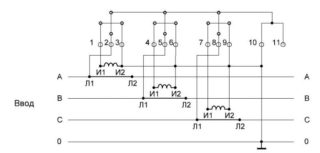
With an indirect connection, the electric meter is included in the monitored circuit according to several schemes developed specifically for this method. One of them is the connection by means of ten separate conductive wires. With its help, it is possible to realize separate metering of current and voltage, which increases the efficiency and safety of the device in all modes. The disadvantage of this method is considered to be a large number of switching elements that reduce the reliability of the counter's performance of its functions.
This category includes a circuit that allows the meter to be connected to a three-phase three-wire network by means of 2 current transformers and 2 voltage converters. When applied, it is possible to somewhat reduce the number of required switchings and increase the reliability and safety of the accounting equipment operation.
Nuances of connecting the meter via TT
- Ten-wire circuit.
- Its seven-wire analogue.
- Scheme with combined circuits.
In the first case, three wires from each of the phase lines plus neutral and two wires from 3 CTs are connected to the meter junction box. The advantages of this approach include the optional disconnection of the supply line when it is necessary to replace the electricity meter or when carrying out repair work. In addition, with this switching method, the reliability of its operation and the safety of operation are increased. The disadvantage of this method is that there are more connecting wires.
When using a seven-wire circuit, the three mating ends of the current transformers are combined and connected to ground (10-3 = 7). Simultaneously with the convenience of repairing electrical equipment, in this case, the number of switched wires is reduced. This simplifies the installation and repair of electrical equipment and significantly reduces the risks during its operation in normal modes. It is also possible to connect an electric meter according to a combined scheme, when voltage circuits are combined with current taps by installing jumpers at the appropriate points of the transformers.Usually they are arranged between the I1 taps of the current transformers and the corresponding phase line. The number of connecting conductors in this case remains the same - seven cores.
When choosing a suitable option for connecting the Mercury 230 electric meter, first of all, they proceed from safety reasons. Only after fulfilling this requirement are the issues of economy and ease of maintenance or repair considered.

